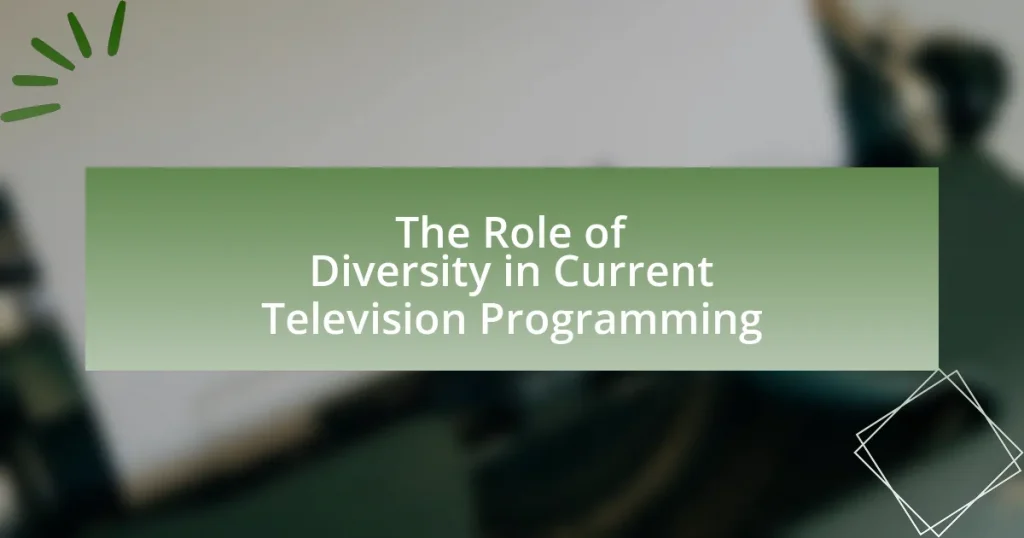The article examines the critical role of diversity in current television programming, highlighting its importance in reflecting societal realities and promoting inclusivity. It discusses the evolution of diversity in television from the mid-20th century to the present, influenced by historical events such as the Civil Rights Movement and changing audience demographics. The article also explores the impact of diverse representation on storytelling, audience engagement, and viewership, supported by research indicating that diverse casts lead to higher ratings and commercial success. Additionally, it addresses the challenges creators face in promoting diversity and outlines best practices for enhancing representation in the industry.

What is the Role of Diversity in Current Television Programming?
Diversity in current television programming plays a crucial role in reflecting societal realities and promoting inclusivity. By incorporating a wide range of perspectives, backgrounds, and experiences, television shows can resonate with a broader audience, fostering empathy and understanding among viewers. Research indicates that diverse representation leads to higher viewer engagement; for instance, a 2020 study by the USC Annenberg Inclusion Initiative found that films and television shows with diverse casts perform better at the box office and attract larger audiences. This demonstrates that diversity not only enriches storytelling but also drives commercial success in the entertainment industry.
How has diversity evolved in television programming over the years?
Diversity in television programming has significantly evolved from the mid-20th century to the present day, transitioning from predominantly white casts to more inclusive representations of various racial, ethnic, and gender identities. In the 1960s and 1970s, shows like “The Jeffersons” and “Good Times” began to introduce African American characters and storylines, reflecting societal changes and the civil rights movement. By the 1990s, series such as “Friends” and “The Fresh Prince of Bel-Air” showcased a broader range of cultural backgrounds, although often still within a predominantly white context.
In the 2010s, the landscape shifted dramatically with the rise of streaming platforms, leading to shows like “Orange Is the New Black” and “Master of None,” which featured diverse casts and explored intersectional themes. According to a 2021 report by the USC Annenberg Inclusion Initiative, 43% of lead characters in film and television were from underrepresented racial and ethnic groups, a notable increase from previous decades. This evolution reflects a growing recognition of the importance of representation in media, driven by audience demand for authentic storytelling that resonates with a wider demographic.
What historical events have influenced diversity in television?
The Civil Rights Movement in the 1960s significantly influenced diversity in television by advocating for the representation of African Americans and other marginalized groups. This movement led to the introduction of shows like “The Cosby Show” in the 1980s, which portrayed African American families in a positive light, challenging stereotypes. Additionally, the 1990s saw the rise of multicultural programming, spurred by demographic changes and the push for inclusivity, exemplified by series such as “Fresh Prince of Bel-Air.” The implementation of the Federal Communications Commission’s (FCC) policies in the 1970s and 1980s also mandated greater representation of diverse voices in media, further shaping the landscape of television diversity.
How have audience demographics changed in relation to television programming?
Audience demographics have shifted significantly in relation to television programming, with increased representation of diverse racial, ethnic, and gender groups. For instance, the percentage of lead roles held by actors of color in prime-time television rose from 22% in 2015 to 36% in 2020, according to the 2020 Hollywood Diversity Report by the University of California, Los Angeles. This change reflects a broader societal push for inclusivity and representation, as audiences increasingly demand content that reflects their own experiences and identities. Additionally, younger viewers, particularly those aged 18-34, show a preference for diverse storytelling, influencing networks to adapt their programming strategies to attract this demographic.
Why is diversity important in television programming?
Diversity is important in television programming because it reflects the varied experiences and perspectives of society, fostering inclusivity and representation. When television shows feature diverse characters and stories, they resonate with a broader audience, enhancing viewer engagement and satisfaction. Research from the USC Annenberg Inclusion Initiative indicates that films and television series with diverse casts perform better at the box office and attract larger audiences, demonstrating that diversity not only enriches storytelling but also drives economic success.
What impact does diversity have on storytelling and representation?
Diversity significantly enhances storytelling and representation by introducing a wider range of perspectives and experiences. This inclusion allows narratives to resonate with a broader audience, fostering empathy and understanding among viewers. Research from the USC Annenberg Inclusion Initiative indicates that diverse representation in media leads to more authentic storytelling, as it reflects the complexities of real-world experiences. Furthermore, shows with diverse casts and storylines have been shown to perform better in terms of viewership and critical acclaim, demonstrating that audiences appreciate and seek out varied narratives.
How does diversity affect audience engagement and viewership?
Diversity positively affects audience engagement and viewership by fostering a sense of representation and relatability among diverse demographic groups. When television programming includes a variety of cultural, racial, and gender identities, it attracts a broader audience, as viewers are more likely to engage with content that reflects their own experiences and backgrounds. Research from the USC Annenberg Inclusion Initiative indicates that shows with diverse casts tend to have higher ratings and viewership, demonstrating that inclusivity can drive commercial success. Furthermore, Nielsen reports that diverse programming can enhance viewer loyalty, as audiences feel more connected to stories that resonate with their identities.
What are the current trends in diversity within television programming?
Current trends in diversity within television programming include increased representation of various racial, ethnic, and gender identities, as well as the inclusion of LGBTQ+ characters and storylines. Networks and streaming platforms are actively prioritizing diverse casting and storytelling to reflect the demographics of their audiences. For instance, a 2022 report from the USC Annenberg Inclusion Initiative found that 43% of lead characters in television were from underrepresented racial and ethnic groups, a significant increase from previous years. Additionally, the portrayal of LGBTQ+ characters has also risen, with GLAAD reporting that 10.2% of regular characters on scripted primetime television were LGBTQ+ in 2021, up from 8.8% in 2020. These trends indicate a growing commitment to inclusivity and representation in the television industry.
Which genres are leading in diverse representation?
The genres leading in diverse representation are drama and comedy. These genres have increasingly showcased a variety of cultural, racial, and gender identities, reflecting broader societal changes. For instance, shows like “Pose” and “Insecure” have received critical acclaim for their authentic portrayals of LGBTQ+ and Black experiences, respectively. According to a 2021 report by the USC Annenberg Inclusion Initiative, scripted television has seen a rise in representation, with 40% of series regulars being people of color in the 2020-2021 season, indicating a significant shift towards inclusivity in these genres.
How are streaming platforms influencing diversity in programming?
Streaming platforms are significantly influencing diversity in programming by providing a broader range of content that reflects various cultures, identities, and experiences. These platforms, such as Netflix and Amazon Prime, have invested in original programming that showcases underrepresented voices, leading to a more inclusive media landscape. For instance, Netflix’s commitment to diversity is evident in its production of series like “Orange Is the New Black,” which features a predominantly female cast with diverse racial and sexual identities, and “Master of None,” which explores the experiences of an Indian-American man. According to a 2021 report by the USC Annenberg Inclusion Initiative, streaming platforms have outperformed traditional networks in terms of representation, with 40% of lead roles in streaming content being held by people of color, compared to 27% in broadcast television. This shift not only enhances visibility for marginalized groups but also encourages the creation of diverse narratives that resonate with a global audience.
How do networks and producers approach diversity in their programming?
Networks and producers approach diversity in their programming by actively seeking to represent a wide range of voices, cultures, and experiences. This commitment is evident in initiatives such as the inclusion of diverse writers, directors, and cast members, which aims to create authentic narratives that resonate with varied audiences. For instance, a 2021 report from the USC Annenberg Inclusion Initiative found that shows with diverse casts and crews are more likely to achieve higher ratings and critical acclaim, demonstrating that diversity not only enriches storytelling but also enhances commercial success.
What challenges do creators face in promoting diversity in television?
Creators face significant challenges in promoting diversity in television, primarily due to industry resistance and financial constraints. The television industry often prioritizes established formulas that appeal to broad audiences, which can limit the willingness to invest in diverse narratives. Additionally, creators may encounter difficulties in securing funding and support for projects that feature underrepresented groups, as networks and studios may perceive these projects as less commercially viable. According to a 2021 report by the USC Annenberg Inclusion Initiative, only 28.4% of characters in film and television were from underrepresented racial and ethnic groups, highlighting the systemic barriers that persist. These challenges underscore the need for ongoing advocacy and structural change within the industry to foster a more inclusive environment.

What are the effects of diversity on television audiences?
Diversity in television programming positively affects audiences by enhancing representation and fostering inclusivity. When diverse characters and stories are portrayed, viewers from various backgrounds feel seen and validated, which can lead to increased engagement and loyalty to the content. Research indicates that shows with diverse casts attract larger audiences; for instance, a study by Nielsen found that 47% of viewers prefer shows that reflect their own cultural backgrounds. Furthermore, diverse programming can challenge stereotypes and broaden perspectives, contributing to a more informed and empathetic audience. This shift not only benefits viewers but also drives higher ratings and advertising revenue for networks, demonstrating the economic impact of diversity in television.
How does diverse representation impact viewer perceptions?
Diverse representation significantly enhances viewer perceptions by fostering inclusivity and relatability. When television programming features a variety of characters from different backgrounds, it allows audiences to see themselves reflected in the narratives, which can lead to increased engagement and emotional connection. Research indicates that shows with diverse casts, such as “Black Panther” and “Crazy Rich Asians,” not only perform well at the box office but also positively influence viewers’ attitudes towards different cultures. A study published in the Journal of Communication found that exposure to diverse characters can reduce stereotypes and promote empathy among viewers, demonstrating that representation plays a crucial role in shaping societal perceptions and attitudes.
What studies support the benefits of diversity in television?
Studies supporting the benefits of diversity in television include the 2020 report by the Annenberg Inclusion Initiative, which found that diverse casts lead to higher ratings and greater audience engagement. Additionally, a study published in the Journal of Broadcasting & Electronic Media in 2019 demonstrated that diverse representation positively influences viewer perceptions and increases relatability among audiences. Furthermore, research from the University of Southern California in 2018 indicated that films and shows with diverse representation perform better at the box office, highlighting the economic advantages of inclusivity in media. These studies collectively underscore the positive impact of diversity on both audience reception and financial success in television programming.
How do viewers respond to diverse characters and storylines?
Viewers generally respond positively to diverse characters and storylines, as they enhance relatability and representation. Research indicates that shows featuring diverse casts can lead to increased viewer engagement and satisfaction. For instance, a study by the Geena Davis Institute on Gender in Media found that 67% of viewers believe that diversity in media positively impacts society. Furthermore, Nielsen reported that diverse programming attracts a broader audience, with 50% of respondents expressing a preference for shows that reflect a variety of cultures and experiences. This demonstrates that diverse characters and narratives not only resonate with viewers but also contribute to a more inclusive media landscape.
What role do audiences play in shaping diversity in television programming?
Audiences play a crucial role in shaping diversity in television programming by influencing content creators and networks through their viewing preferences and feedback. When audiences demand more representation and diverse narratives, networks respond by developing shows that reflect these desires, as evidenced by the success of series like “Black Panther” and “Crazy Rich Asians,” which highlighted underrepresented communities and achieved significant box office success. Additionally, studies show that diverse programming can lead to higher ratings and increased advertising revenue, further motivating networks to prioritize inclusivity in their offerings.
How can audience feedback influence programming decisions?
Audience feedback can significantly influence programming decisions by providing insights into viewer preferences and expectations. Television networks and producers analyze audience reactions through ratings, social media interactions, and surveys to understand which content resonates with viewers. For instance, a study by Nielsen found that shows with diverse casts often receive higher viewer engagement, leading networks to prioritize inclusive programming to attract broader audiences. This data-driven approach ensures that programming aligns with audience interests, ultimately enhancing viewer satisfaction and loyalty.
What platforms exist for audiences to advocate for diversity?
Audiences can advocate for diversity through various platforms, including social media, petitions, and community organizations. Social media platforms like Twitter, Instagram, and Facebook allow users to share their views, mobilize support, and raise awareness about diversity issues in television programming. Online petition sites such as Change.org enable individuals to create and sign petitions demanding more diverse representation in media. Additionally, community organizations and advocacy groups, such as GLAAD and the NAACP, provide resources and campaigns focused on promoting diversity and inclusion in entertainment. These platforms collectively empower audiences to voice their concerns and influence industry practices regarding diversity.

What best practices can be adopted to enhance diversity in television programming?
To enhance diversity in television programming, networks should prioritize inclusive storytelling by featuring a wide range of voices and perspectives. This can be achieved by hiring diverse writers, directors, and producers who can authentically represent various cultures and experiences. Research from the USC Annenberg Inclusion Initiative indicates that shows with diverse casts and crews are more likely to resonate with broader audiences, leading to increased viewership and engagement. Additionally, implementing mentorship programs for underrepresented talent can foster a more inclusive industry, as evidenced by initiatives like the WarnerMedia Access Writers Program, which has successfully increased diversity in writing rooms.
How can networks ensure authentic representation in their shows?
Networks can ensure authentic representation in their shows by actively involving diverse voices in the creative process, including writers, directors, and actors from various backgrounds. This approach fosters genuine storytelling that reflects the experiences and perspectives of underrepresented communities. Research indicates that shows with diverse teams are more likely to portray characters and narratives that resonate authentically with audiences, as seen in the success of series like “Black Panther,” which featured a predominantly Black cast and crew, leading to critical acclaim and box office success. By prioritizing diversity in hiring practices and storytelling, networks can create content that is both authentic and relatable.
What strategies can be implemented to recruit diverse talent behind the scenes?
To recruit diverse talent behind the scenes, organizations can implement targeted outreach initiatives, establish partnerships with diverse organizations, and create inclusive hiring practices. Targeted outreach initiatives involve actively seeking candidates from underrepresented groups through job fairs, community events, and online platforms that cater to diverse populations. Establishing partnerships with organizations that focus on diversity, such as cultural institutions or educational programs, can provide access to a broader talent pool. Inclusive hiring practices, such as using blind recruitment techniques and diverse hiring panels, help mitigate bias and ensure a fair evaluation of candidates. Research indicates that diverse teams lead to more innovative solutions and better decision-making, reinforcing the importance of these strategies in enhancing creativity and representation in television programming.
How can storytelling be improved to reflect diverse experiences?
Storytelling can be improved to reflect diverse experiences by incorporating authentic voices and perspectives from various cultural backgrounds. This approach ensures that narratives resonate with a broader audience and accurately depict the complexities of different communities. Research indicates that diverse representation in media leads to increased viewer engagement and satisfaction; for instance, a study by the Annenberg Inclusion Initiative found that films with diverse casts perform better at the box office. By prioritizing inclusivity in character development, plotlines, and creative teams, storytelling can authentically mirror the rich tapestry of human experiences.
What resources are available for promoting diversity in television?
Resources available for promoting diversity in television include initiatives by organizations such as the National Association for the Advancement of Colored People (NAACP), which provides advocacy and support for diverse representation in media. Additionally, the Writers Guild of America offers programs aimed at increasing diversity among writers and creators in television. Research from the Annenberg Inclusion Initiative highlights that diverse casting and storytelling can lead to higher ratings and broader audience engagement, demonstrating the importance of these resources in enhancing representation. Furthermore, funding opportunities from networks and production companies specifically aimed at diverse projects help to foster a more inclusive television landscape.
Which organizations support diversity initiatives in the industry?
Organizations that support diversity initiatives in the television industry include the National Association of Black Journalists (NABJ), the Asian American Journalists Association (AAJA), and GLAAD. These organizations actively promote diversity by providing resources, advocacy, and networking opportunities for underrepresented groups in media. For instance, NABJ focuses on increasing the representation of Black journalists and media professionals, while AAJA works to ensure fair representation of Asian Americans in journalism. GLAAD advocates for LGBTQ+ representation and inclusion in media, highlighting the importance of diverse voices in storytelling.
How can creators access funding for diverse projects?
Creators can access funding for diverse projects through various channels such as grants, crowdfunding platforms, and partnerships with organizations that support diversity in media. For instance, the National Endowment for the Arts offers grants specifically aimed at promoting diverse artistic expressions. Additionally, platforms like Kickstarter and Indiegogo allow creators to raise funds directly from supporters who are interested in diverse content. Collaborating with production companies that prioritize diversity can also provide financial backing and resources. These funding avenues are essential as they help to ensure that underrepresented voices and stories are brought to the forefront in television programming.
What are practical steps for viewers to support diversity in television programming?
Viewers can support diversity in television programming by actively seeking out and watching shows that feature diverse casts and stories. This action increases demand for inclusive content, encouraging networks and producers to invest in diverse programming. Research from the Annenberg Inclusion Initiative indicates that diverse representation in media leads to broader audience engagement and higher ratings, demonstrating that viewer choices directly impact industry practices. Additionally, viewers can participate in discussions on social media, advocating for diverse narratives and supporting creators from underrepresented backgrounds, further amplifying the call for diversity in television.




